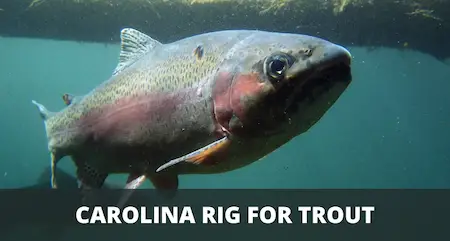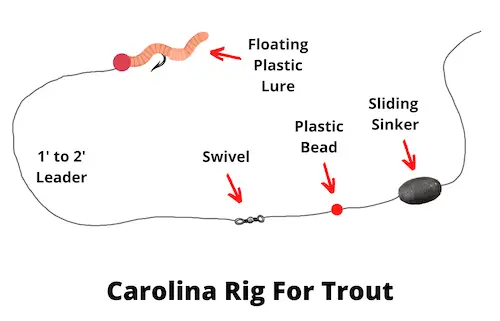How To Fish A Carolina Rig For Trout (Detailed Guide)
UPDATED 03 NOVEMBER 2023
by Robert Ceran
Carolina rigs have been around for more than a hundred years, and are currently most popular for bass fishing.
But since trout like to hold close to the bottom in many situations, this means you can use this rig for catching trout as well.
It’s also very easy to set up and use a Carolina rig, so it’s a great option for beginners and advanced anglers alike.

Here I’ll cover in detail how to tie a Carolina rig for trout, as well as the best techniques and baits to use with it for trout fishing.
Can you use a Carolina rig for trout?
Yes, using a Carolina rig is a great option for trout fishing, as it allows you to present your bait close to the bottom, which is where trout often feed.
However, when trout are suspended higher in the water column, this rig is not the best choice, and you should switch to a bobber rig instead.
Also keep in mind that even when trout are holding close to the bottom, they almost never pick up food directly from the bottom, and instead prefer to eat food that’s suspended in the water close to the bottom.
So in order to use a Carolina rig for trout effectively, you need to combine it with floating baits or floating lures.
Is a Carolina rig good for trout fishing?
Yes, Carolina rigs are among the best setups for trout fishing in places where trout are found close to the bottom.
If you use it correctly, your bait will be presented one or two feet above the bottom, which is ideal for catching trout most of the time.
A big advantage of the Carolina rig is that it can be fished both passively (by waiting for trout to come by and eat your bait) or actively (by retrieving your rig and working a floating lure close to the bottom).
Taken together, these advantages make the Carolina rig one of the best bottom fishing rigs for trout.
How to tie a Carolina rig for trout

Now let’s talk about the Carolina rig setup for trout. Here are the components you’ll need for the whole setup:
- 7’ to 8’ ultralight power spinning rod
- 1000 to 2000 size spinning reel
- 6 to 10 lb test main line (braid or fluorocarbon)
- 4 to 6 lb test fluorocarbon leader
- 1/8 or 1/4 oz sliding sinker (egg or bullet sinker)
- Plastic bead
- Size 8 barrel swivel
- Size 8 to 12 hook (either single or treble)
Once you’ve spooled your spinning reel with the main line, you’re ready to start tying the rig.
Start by threading a 1/8 or 1/4 oz sliding sinker onto your main line (you can use either a bullet sinker or an egg sinker, depending on your preference).
Next, thread a plastic bead on to the line, and then tie your main line to a size 8 barrel swivel.
After you’ve tied the swivel on to the main line, take your fluorocarbon leader line, and tie it to the other end of your swivel.
Then measure out about 12 to 24 inches of leader, and cut it off from the spool. Now tie on a size 8 hook to the end of the leader line.
Your choice of hook type depends on the bait you plan to use. A treble hook works great with powerbait, since you can insert it completely into a ball of powerbait, and mold the powerbait around it to hide the hook completely.
I’ve found that a treble hook is better at keeping powerbait from falling off the hook, and it also generates more successful hookups.
If you’re using a worm, on the other hand, it’s better to use a single hook. The best type of hook to use is a baitkeeper hook, which has two additional barbs on its shank.
This stops a worm from sliding down the hook and forming a tight ball at the bottom of the hook. You really need a worm to be stretched out in the water in order to trigger bites from trout.
Slip sinker rig vs Carolina rig
If you compare a slip sinker rig to a Carolina rig, you’ll notice that they are very similar. So what’s the difference between them?
The only real difference between the two rigs is that the Carolina rig is most often used with artificial lures, while the slip sinker is more often used with a baited hook.
In addition to this, a slip sinker rig is tied without a bead between the sinker and the swivel, while a Carolina rig includes the bead.
The advantage of placing a bead between the sliding sinker and the swivel is that it protects the knot on the swivel from being damaged every time the sliding sinker bangs into it. This makes the Carolina rig more robust, and less likely to break.
What is the best Carolina rig bait for trout?
The best bait to use with a Carolina rig for trout is either floating powerbait or a nightcrawler worm that has been injected with air to make it float.
While a Carolina rig enables you to present your bait close to the bottom, you need to make sure the baited hook doesn’t lie directly on the bottom, as trout only eat bait suspended above the bottom, and ignore your bait if it’s lying on the bottom.
Because of this, it’s essential to use a bait that is buoyant enough to lift your hook up in the water, so it ends up suspended about 1 or 2 feet above the bottom (depending on the length of your leader).
If you use a treble hook baited with powerbait, check to see if the baited hook floats or sinks in the water. You can easily do this at home by placing it in a glass of water.
If you notice that it sinks, either increase the size of the powerbait ball, or decrease the size of the hook. Play around with this until you find a combination that floats reliably.
On the other hand, if you’re using worms as bait, you need to inject air into the worm to make it float in the water.
You can get a worm syringe kit from your tackle store, and you should also make sure to test this at home.
Bait your hook with a fragment of worm, inject air into it, and then see if it floats in a glass of water.
Carolina rig with floating jig head
An alternative to using powerbait or live worms on your Carolina rig is to use artificial lures instead.
But if you choose this option you need to make sure the lures you’re using actually float in the water.
Great options are floating jig heads that can be combined with a variety of plastic lures, and another option is to use a power worm combined with a lightweight hook.
How to fish a Carolina rig for trout
There are two main ways to fish a Carolina rig for trout.
The first option is to cast it out with a floating bait like powerbait or an inflated worm, and then leave the rig in place while waiting for a trout to eat the bait (which is a great strategy when fishing for trout at night).
The second option is to fish a Carolina rig with a floating artificial lure, such as a floating jig head baited with a plastic worm.
In the latter case you need to actively retrieve the rig to get the lure to move attractively in the water, in a manner that triggers trout to bite.
No matter which of these options you choose, it’s important to give the trout enough time to eat the bait before you set the hook.
he great thing about using a sliding sinker is that the fish can grab the bait without feeling a lot of resistance, thus giving it more time to get the bait completely inside its mouth before you set the hook.
When you actively throw and retrieve a Carolina fishing rig, this helps to cover more ground, but it also requires more skill and technique to implement effectively.
And keep in mind that the mood of the fish changes from day to day, and sometimes they just prefer baits to lures.
An ideal way to cover both options is to set up a trout rod baited with powerbait or a worm, and then using another rod to throw lures.
One of the best techniques for fishing a Carolina rig with a floating lure (such as a power worm), is to let the rig sink to the bottom, followed by lifting up the tip of your rod by 4 or 5 feet, and then lowering it again while you reel in the slack.
Make sure you don’t retrieve your rig too fast, as you want to give the trout plenty of time to come closer and check out the lure as it follows the sinker.
And when you do feel a bite, give it at least 3 seconds before setting the hook with your trout rod, as you’ll get a higher hookup ratio.
